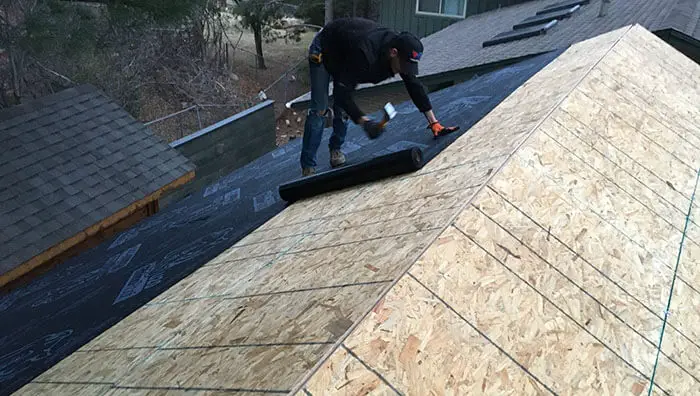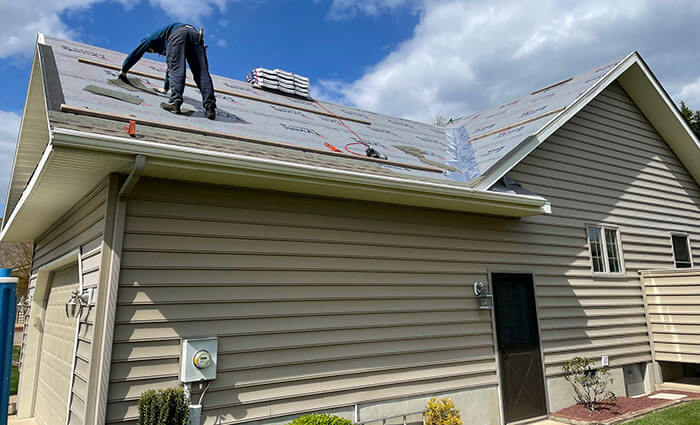Yes, synthetic roof underlayment can get wet. As you already might know, they are designed to be waterproof and can withstand exposure to moisture, but they can get wet. I know because I experienced it myself a couple of years back.
Of course, it won’t give your roof proper shelter or barrier from the water, but it sure does provide a temporary layer of protection during construction or in the event of a roofing system failure.
I need to discuss this in detail to give you a proper understanding of this issue. Let’s get into those by one.
Quick Jump
How Long Can Synthetic Roof Underlayment Be Exposed?

Synthetic roof underlayment can be exposed for up to four to six weeks, as it can become an issue of deterioration. And even tearing, wrinkling, or buckling can happen, as it happens when your roof is without shingles.
Sometimes, your roof can get exposed for many reasons, such as strong winds, storms, or weather conditions. Also, synthetic underlayment can still be damaged or compromised if exposed to excessive moisture for prolonged periods.
Other than these, there are also a few factors you need to consider, such as UV exposure, moisture, and wind exposure, and the installment method also affects.
Depending on the sunlight, meaning the UV exposure, synthetic underlayment might deteriorate and break down more quickly. Besides, rain or high humidity can cause some types of underlayment to absorb moisture, and high winds can cause the underlayment to tear or become dislodged.
What to Do When Synthetic Roof Underlayment Gets Wet?
There are proper measurements to take if there are clear signs that your synthetic roof underlayment is wet. Before you do anything, ensure that it dries completely before further work is done on the roof. The process may take a few hours or even a full day, depending on the temperature, humidity, and air circulation, but it is necessary.
After that, you need to evaluate the extent of the damage. To ensure that, you might just let it dry; if there are no significant issues, it will be fine. But in some cases, if the damage is vast and the underlayment was wet for a long time, you might need to replace that part entirely, as it can be prone to tearing and may not provide adequate protection for the roof.
Depending on the situation, you must replace a small or significant part of the synthetic roof underlayment and take some preventive measures.
To help you understand, here are something you need to check to understand the situation better.
# You might notice only a tiny portion of the underlayment has gotten wet, and the water exposure is minimal. In that case, it may be possible to dry the underlayment thoroughly and continue using it. But, if the situation is the opposite, you should replace that.
# The replacement may be necessary If the underlayment has been wet for an extended period, as it might weaken or deteriorate.
# Wait no longer if there are any signs of damage, such as tearing, wrinkling, or buckling.
You will know if you need to replace the entire thing or just a few repairs.
How to Replace Synthetic Roof Underlayment If They Get Wet

Whether it’s a minor repair or replacement or a big one, here are some steps on how you’re doing to do that.
Step #1: You need to start with removing the damaged underlayment. Be careful not to damage the roof or anything else.
Step #2: Measure the damaged part and cut that portion from the new one to replace it. Ensure that the seams overlap correctly, and don’t forget to use sealant around any penetrations or edges.
Step #3: Get roofing nails or staples to secure the new underlayment to the roof deck. Be sure to space the fasteners properly and avoid overdriving them.
Step #4: Install roofing materials such as shingles or tiles when that part is done. That will conclude the primary repair or replacement of a piece.
Step #5: Even though you’re done with replacing the underlayment, remove or clean up any debris from the roof or near that area.
Yes, I know, that part is straightforward, but no one wants to go through that hassle again because I have been and never want to. That’s why I learned some prevention techniques, which I will share with you in the following section.
How to Prevent Synthetic Roof Underlayment from Getting Wet
You don’t want to compromise the roof underlayment’s effectiveness as a temporary water barrier, nor do I. In this part, I will help you with that.
- I hope you considered all the weather conditions while making the roofing plans and that the materials are correctly selected. If there is any issue, you must reconsider the entire roofing project.
- When I said considering the weather conditions, I also meant the time you’re installing the underlayment. Check the weather forecast before starting the roofing project. Avoid installing the underlayment when rain is forecasted.
- Even if you started without considering that, ensure you have adequate tarps to cover the roof and prevent water infiltration.
- Many owners make the mistake of installing improper flashing around roof penetrations, inadequate ventilation, and installing the wrong drip edges, don’t do that.
- As I mentioned, ensure the underlayment is properly overlapped and fastened repeatedly.
- Cover the underlayment with a tarp or other waterproof material if you’re going away.
- Under no circumstances, never schedule roofing work during rainy or stormy weather conditions; always choose dry weather.
That’s more or less the prevention tactics. The bottom line is never to take any risks by letting those wet and have a proper installation process with suitable materials if you want to save your precious money, time, and energy in the future.
Wrap Up
That was everything I could cover on this particular topic. Of course, you know that the synthetic roof underlayment can get wet. But there are always ways to get out of trouble such as this.
Remember to fix the issue as soon as possible, and don’t let it be exposed for more than six to eight weeks. If the coverage is big enough, you need to replace that part, and I also provided enough information on that and prevention methods.
Have a good day!

Roger Lewis is an experienced roof repair contractor with over 15 years of industry experience. He is known for his expertise in all aspects of roof repair, including leak detection, shingle replacement, and gutter repair.
